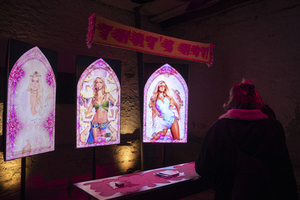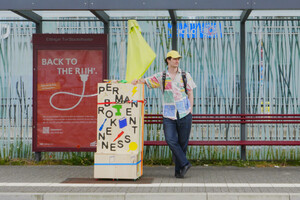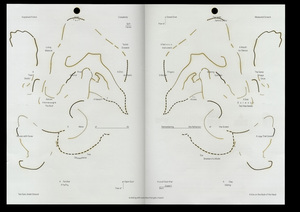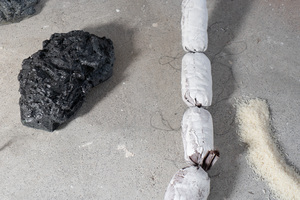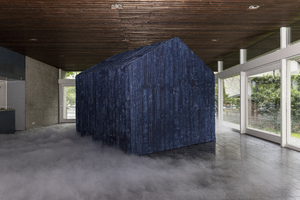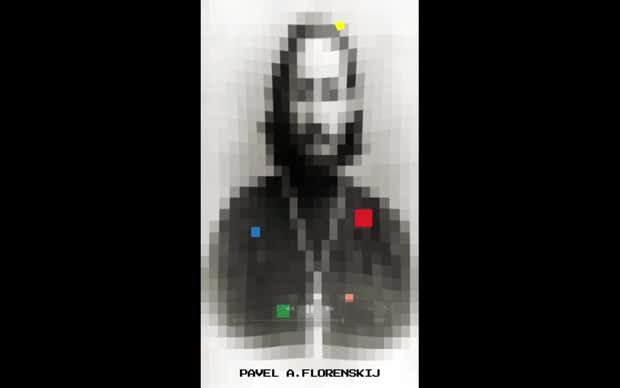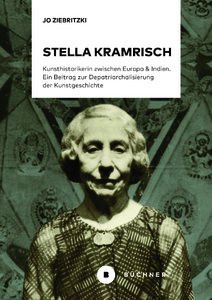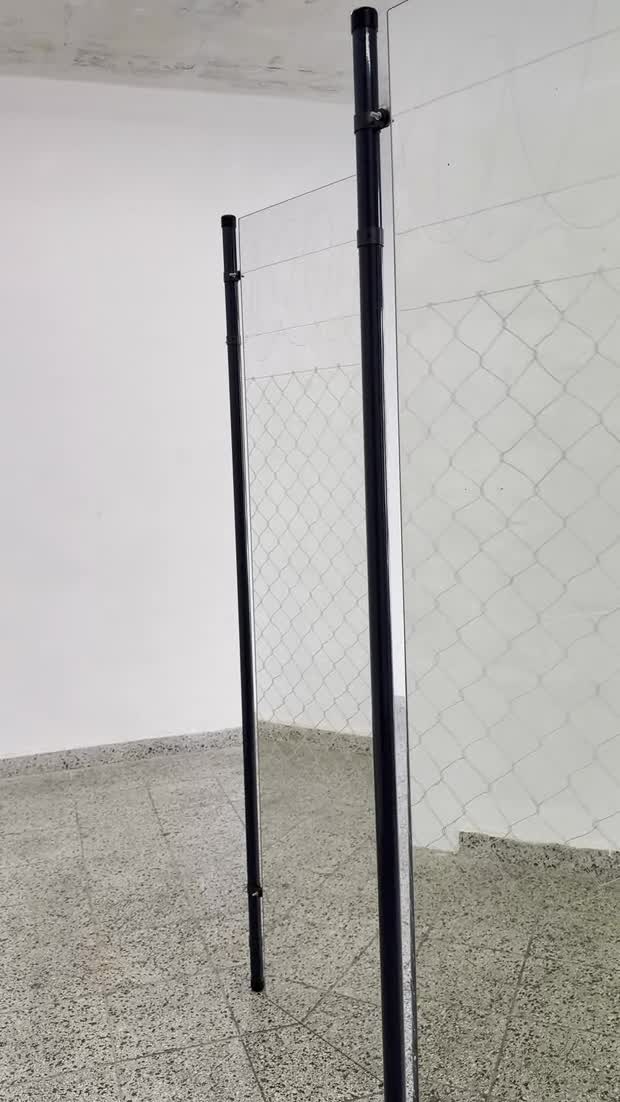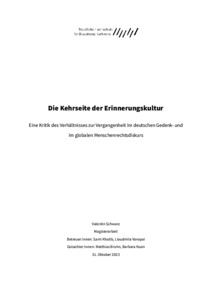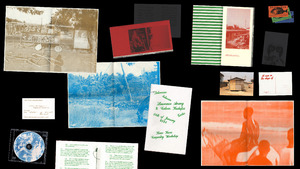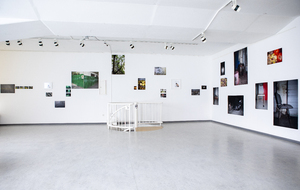The Plenum – A Scripted Play
Benachbarte Sets (34)Alle Zusammenhänge anzeigen
Diese Sets wurden den gleichen Sets hinzugefügt wie das ausgewählte Set.
34 Inhalte
- Seite 1 von 3
WHERE LEGENDS ARE MADE AND LIES ARE TOLD
- Titel
- WHERE LEGENDS ARE MADE AND LIES ARE TOLD
- Autor/in
- Beschreibung (de)
- WHERE LEGENDS ARE MADE AND LIES ARE TOLD (graduation project). Originated by this divine union of @parishilton @britneyspears @lindsaylohan (aka the Holy Trinity <3) the night of the infamous Bimbo Summit, WLAMALAT is the visual and critical translation of my obsession for the #y2k it-girls and #popculture in general. Mixing a religious with a highly commercial aesthetic, the project questions several topics such as women representation in the mass media, visual/celebrity culture consumption and new belief systems.
- WHERE LEGENDS ARE MADE AND LIES ARE TOLD (graduation project). Originated by this divine union of @parishilton @britneyspears @lindsaylohan (aka the Holy Trinity <3) the night of the infamous Bimbo Summit, WLAMALAT is the visual and critical translation of my obsession for the #y2k it-girls and #popculture in general. Mixing a religious with a highly commercial aesthetic, the project questions several topics such as women representation in the mass media, visual/celebrity culture consumption and new belief systems.
- Beschreibung (en)
- WHERE LEGENDS ARE MADE AND LIES ARE TOLD (graduation project). Originated by this divine union of @parishilton @britneyspears @lindsaylohan (aka the Holy Trinity <3) the night of the infamous Bimbo Summit, WLAMALAT is the visual and critical translation of my obsession for the #y2k it-girls and #popculture in general. Mixing a religious with a highly commercial aesthetic, the project questions several topics such as women representation in the mass media, visual/celebrity culture consumption and new belief systems.
- WHERE LEGENDS ARE MADE AND LIES ARE TOLD (graduation project). Originated by this divine union of @parishilton @britneyspears @lindsaylohan (aka the Holy Trinity <3) the night of the infamous Bimbo Summit, WLAMALAT is the visual and critical translation of my obsession for the #y2k it-girls and #popculture in general. Mixing a religious with a highly commercial aesthetic, the project questions several topics such as women representation in the mass media, visual/celebrity culture consumption and new belief systems.
- Kategorie
- Typ des Projekts/Werks
- Datierung
- 06.12.23
- Dank an
- Ort
- Rudolf 5
- Titel
- WHERE LEGENDS ARE MADE AND LIES ARE TOLD
- Projektleiter/in
- Semester
- Studiengang
- Typ der Abschlussarbeit
- Importiert am
- 05.11.2024
- Übergeordnete Sets
- 1
- Set enthält
- 3 8
PERMANENT BROKENNESS
- Titel
- PERMANENT BROKENNESS
- Autor/in
- Beschreibung (de)
- PERMANENT BROKENNESS ist eine mobile (Infra-)Struktur, die das transformative Potential von öffentlichen Orten aufzeigt, indem sie die Reparatur von Haushalts- und Konsumgeräten verfügbar und sichtbar macht. Angelehnt an das Format des Reparatur-Cafés, werden Benutzer*innen dazu eingeladen eigenständig und gemeinsam Dinge zu reparieren. Hierbei steht nicht nur die Müllvermeidung und Ressourcenschonung im Vordergrund, sondern vor allem der selbstwirksame Zugang zur dinglichen Umwelt. Das Projekt basiert auf einer umfangreichen Recherche zur kulturellen Praxis des Reparierens und formuliert ein Gegennarrativ zu Hegemonien der Produktion, der Innovation und des unreflektierten Massenkonsums.
- Beschreibung (en)
- PERMANENT BROKENNESS is a mobile (infra-)structure that demonstrates the transformative potential of public spaces by making the repair of household and consumer appliances available and visible. Inspired by the repair café format, users are invited to repair things independently and together. The focus here is not only on avoiding waste and conserving resources, but above all on self-effective access to the material environment. The project is based on extensive research into the cultural practice of repairing and formulates a counter-narrative to hegemonies of production, innovation and unreflected mass consumption.
- Kategorie
- Schlagworte
- Datierung
- 26.06.2024
- Mitwirkende
- Dank an
- Titel
- PERMANENT BROKENNESS
- Projektleiter/in
- Semester
- Studiengang
- Typ der Abschlussarbeit
- Importiert am
- 01.11.2024
- Übergeordnete Sets
- 1
- Set enthält
- 0 6
I Cried A Smile
- Titel
- I Cried A Smile
- Autor/in
- Beschreibung (de)
- Mit den Mitteln einer wissenschaftlichen Lecture erzählt „I Cried A Smile“ eine Geschichte über eine Person mit 2 Köpfen, Holz das zu Menschen wird, und die Erinnerung daran als Kind mit Neuropsychologie in Kontakt zu treten. Zwei übereinander hängende Projektionsflächen zeigen Zeichnungen, Animationen und gefundenes Bildmaterial während meine Stimme vom Band läuft und ich an einem Schreibtisch sitzend, mit dem Verfahren „Lip-Sync“ lautlos mitspreche. Das Publikum sitzt wie in einem anatomischen Theater in zwei Halbkreisen um mich herum.
- Beschreibung (en)
- Using the means of a scientific lecture, “I Cried A Smile” tells a story about a person with two heads, wood that becomes human, and the memory of coming into contact with neuropsychology as a child. Two projection screens hanging above me showcasing drawings, animations and found footage while my voice runs from the tape and I, sitting at a desk, speak along inaudibly using the “Lip-Sync” method. The audience sits around me like in an anatomical theater.
- Using the means of a scientific lecture, “I Cried A Smile” tells a story about a person with two heads, wood that becomes human, and the memory of coming into contact with neuropsychology as a child. Two projection screens hanging above me showcasing drawings, animations and found footage while my voice runs from the tape and I, sitting at a desk, speak along inaudibly using the “Lip-Sync” method. The audience sits around me like in an anatomical theater.
- Kategorie
- Typ des Projekts/Werks
- Schlagworte
- Mitwirkende
- Technik/Verfahren/Formate
- 2 Channel Video
- Dauer
- 8 Minuten
- Ort: Institution
- Stadt
- Land
- Titel
- I Cried A Smile
- Importiert am
- 30.09.2024
- Übergeordnete Sets
- 1
- Set enthält
- 0 5
Ghost Story
- Titel
- Ghost Story
- Autor/in
- Beschreibung (en)
- The project was born in response to the passing of an unaccompanied homeless individual in 2018, a person without known family or friends. Her death was cataloged—reduced to data archived in newsrooms and on digital servers. Yet, if this data remains untouched, and her memory fades into obscurity, does her existence persist? She lingers and remains unseen—a paradoxical state of both presence and absence. Within the digital void, she exists as a spectral trace, haunting the silence, waiting to be rediscovered, forever closed in on herself.
Such is the nature of ghosts—the living create them. We resurrect the departed in our own ways, through rituals, texts, and the intangible recipes of memory. We read, we create, we consume, and through this, we invite the dead to inhabit us once more. This project is an assemblage of fragments—an exploration of the processes through which we become haunted by the past.
- The project was born in response to the passing of an unaccompanied homeless individual in 2018, a person without known family or friends. Her death was cataloged—reduced to data archived in newsrooms and on digital servers. Yet, if this data remains untouched, and her memory fades into obscurity, does her existence persist? She lingers and remains unseen—a paradoxical state of both presence and absence. Within the digital void, she exists as a spectral trace, haunting the silence, waiting to be rediscovered, forever closed in on herself.
- Kategorie
- Typ des Projekts/Werks
- Schlagworte
- Datierung
- 18.04.2024
- Dank an
- Sprache
- Material
- Ort
- Pförtnerhäuser, Alter Schlachthof
- Stadt
- Land
- Titel
- Ghost Story
- Projektleiter/in
- Semester
- Studiengang
- Typ der Abschlussarbeit
- Importiert am
- 25.09.2024
- Übergeordnete Sets
- 0
- Set enthält
- 0 9
“I see” “with my voice”
- Titel
- “I see” “with my voice”
- Autor/in
- Beschreibung (de)
- „I see“ „with my voice“ beschäftigt sich mit Themen wie Transformation, Gestaltwandel und Materialität durch ein Zusammenspiel von literarischen Fragmenten und entliehenen Stimmen. Das Ergebnis ist eine nicht-lineare, fluide Erzählung, die die flüchtige Natur von Visionen, Träumen und Metamorphosen einfängt.
- Beschreibung (en)
- “I see” “with my voice” engages with themes of transformation,
shapeshifting, and materiality through an interplay of literary
fragments and borrowed voices, resulting in a non-linear, fluid
narrative that encapsulates the ephemeral nature of visions,
dreams, and metamorphoses.
This project draws substantial inspiration from Alice Notley's
The Descent of Alette, a transformative odyssey that employs
rhythmic spoken language to explore continuous change.
Alongside Notley’s influence, the works of Hildegard von Bingen,
a 12th-century mystic, and the visionary narratives from the
biblical book of Ezekiel, serve as foundational texts that inform
the thematic and structural framework of this piece.
The text is presented as an audio recording, whispered as a 20 minute loop.
Visitors can listen to the piece when pressing their ear against the tents walls.
My objects are performers, maybe even imposters: frozen in a state of change or mimicry. My objects are performers, maybe even imposters: frozen in a state of change or mimicry.
They are skillfull imitators, but you can tell something is off.
Moving along this crack between the believable and the not quite right, I like to engage
with different realities and states of being. The artificial, almost real-life fakeness of their with different realities and states of being. The artificial, almost real-life fakeness of their
surfaces set the stage for my narrative of transformation, imitation and shapeshifting.
1. A wooden house crafted from smooth denim. Made by sanding the grain of wood
onto the denim fabric
2. Heavy fog covering the floor that could be perceived as dew, mixed with a light subtle
smoke of Incense burning.
The fragrance envokes sacred, holy feelings with its warm, resinous smell with peppery The fragrance envokes sacred, holy feelings with its warm, resinous smell with peppery
undertones.
3. 100 cherries made from a thick mixture of honey and almonds. The heavy sweetness
of the stoneless candy-imposter meant to linger in the visitors mouth as it is tasted. of the stoneless candy-imposter meant to linger in the visitors mouth as it is tasted.
A thin gelatine film – imitating the coolnes of cherry skin as it touches the lips A thin gelatine film – imitating the coolnes of cherry skin as it touches the lips
The installation is accompanied by a small reader containing the three part text to be taken The installation is accompanied by a small reader containing the three part text to be taken
home and serve as a keep sake or document of the fleeting spoken text.
The reader is bound with one simple staple. It does not have a beginning or end, but The reader is bound with one simple staple. It does not have a beginning or end, but
rather works like a gif. No cover or back. Just like wheels turning endlessly in a nonlinear rather works like a gif. No cover or back. Just like wheels turning endlessly in a nonlinear
storytelling.
- “I see” “with my voice” engages with themes of transformation,
- Kategorie
- Typ des Projekts/Werks
- Schlagworte
- Datierung
- 18.04.2024
- Sprache
- Ort: Institution
- Ort
- “I see” “with my voice” at ZKM Pavillon, Karlsruhe
- Stadt
- Land
- Titel
- “I see” “with my voice”
- Projektleiter/in
- Semester
- Studiengang
- Typ der Abschlussarbeit
- Importiert am
- 19.09.2024
- Übergeordnete Sets
- 0
- Set enthält
- 0 2
G.O.T.T.A.L.I.S.T.E.N.
- Titel
- G.O.T.T.A.L.I.S.T.E.N.
- Autor/in
- Beschreibung (de)
- "GOTTALISTEN", kurz für „Grab One Terrene Thought And Let It Slide To Eternal Nothingness”, beschäftigt sich mit der Zeit der Oktoberrevolution in Russland im Jahr 1917. Die Klebeband-Leinwände nehmen Bezug auf den Künstler Kasimir Malewitsch, der während dieser Epoche in Russland lebte. Zudem setzt Claus sich mit dem russischen Religionsphilosoph, Priester, Mathematiker und Kunstwissenschaftler Pavel Florenskij auseinander.
- Beschreibung (en)
- "GOTTALISTEN", short for "Grab One Terrene Thought And Let It Slide To Eternal Nothingness", deals with the time of the October Revolution in Russia in 1917. The tape canvases refer to the artist Kasimir Malewitsch, who lived in Russia during this era. Claus also deals with the Russian religious philosopher, priest, mathematician and art historian Pavel Florenskij.
- Kategorie
- Schlagworte
- Titel
- G.O.T.T.A.L.I.S.T.E.N.
- Projektleiter/in
- Semester
- Studiengang
- Typ der Abschlussarbeit
- Importiert am
- 08.08.2024
- Übergeordnete Sets
- 0
- Set enthält
- 1 27
Seminar School of Casablanca
- Titel
- Seminar School of Casablanca
- Kategorie
- Mitwirkende
- Titel
- Seminar School of Casablanca
- Importiert am
- 18.06.2024
- Übergeordnete Sets
- 1
- Set enthält
- 0 0
Afterfire Seminar
- Titel
- Afterfire Seminar
- Beschreibung (de)
- Mit einer Kombination aus praktischen, experimentellen und forschungsbasierten Ansätzen und einem Fokus auf Materialien untersuchten Studierende und Lehrende im Seminar Afterfire unsere Beziehung zum Feuer im Laufe der Geschichte und im Vergleich zu heute. Geleitet von den Gastprofessoren Paco Boekelmann und Kevin Rouff von Studio Thusthat fand das Seminar im Wintersemester 2022/23 an der HfG Karlsruhe statt.
In einer Zeit von Kriegen, knappen Energieressourcen und der Klimakrise konzentrierte sich das Afterfire Seminar auf unsere besondere Übergangszeit, in der wir uns (theoretisch) von fossilen Brennstoffen entfernen und nach neuen Feuerquellen suchen. In Vorträgen, Gastvorträgen, Ortsbesichtigungen, Workshops und Einzelarbeiten untersuchten Studierende und Lehrende die Nutzung von Feuer und verschiedenen Brennstoffen im Laufe der Jahrhunderte und konzentrierten sich dabei auf das, was nach dem Feuer übrig bleibt - die Asche.
Nach einem Besuch des Kohlekraftwerks im Karlsruher Rheinhafen organisierte Studio Thusthat einen Workshop, um den Vorläufer der Steinkohle zu erforschen: die Holzkohle. Die Studierenden schufen Werkstücke, hauptsächlich aus Holz, und bauten einen Ofen, in dem alle Objekte am letzten Tag des Workshops ohne Sauerstoff gebrannt wurden, so dass sie zu Holzkohle wurden.
Der zweite Workshop konzentrierte sich auf die drei "neuen" wichtigsten alternativen Brennstoffsektoren: den Bereich der holzigen Biomasse, den Bereich der landwirtschaftlichen Nebenprodukte und den Bereich der Energiegewinnung aus Abfällen. Zwei Tage lang analysierten die Studierenden in Gruppenarbeit die repräsentativen Brennstoffe Holz, Stroh und Siedlungsabfälle im Hinblick auf die vielen Nuancen, die für und gegen ihre Nutzung als Energiequelle sprechen.
Neben und in Verbindung mit den Workshops wurden im Laufe des Semesters individuelle studentische Projekte entwickelt, die auf den Recherchen von Studio Thusthat aufbauten und eigene Prozesse, Phänomene, Effekte oder Zusammenhänge von Feuer theoretisch und praktisch erarbeiteten.
Am Ende des Semesters wurden alle studentischen Projekte in einer Ausstellung im Lichthof der HfG Karlsruhe präsentiert, wo die Projekte der Öffentlichkeit präsentiert wurden. Eine Auswahl der Projekte, an denen die Studierenden über das Seminar hinaus weitergearbeitet haben, wurde beim Rundgang und bei der Karlsruher Museumsnacht 2023 ausgestellt.
- Mit einer Kombination aus praktischen, experimentellen und forschungsbasierten Ansätzen und einem Fokus auf Materialien untersuchten Studierende und Lehrende im Seminar Afterfire unsere Beziehung zum Feuer im Laufe der Geschichte und im Vergleich zu heute. Geleitet von den Gastprofessoren Paco Boekelmann und Kevin Rouff von Studio Thusthat fand das Seminar im Wintersemester 2022/23 an der HfG Karlsruhe statt.
- Beschreibung (en)
- With a combination of practical, experimental and research-based approaches and a focus on materials, students and teachers in the Afterfire seminar examined our relationship to fire throughout history and in comparison to today. Led by guest professors Paco Boekelmann and Kevin Rouff from Studio Thusthat, the seminar took place in the winter semester 2022/23 at the HfG Karlsruhe.
In a time of wars, scarce energy resources and climate crisis, the Afterfire Seminar focused on our particular transitional period in which we are (theoretically) moving away from fossil fuels and looking for new sources of fire. Through lectures, guest talks, site visits, workshops and individual work, students and teachers explored the use of fire and different fuels over the centuries, focussing on what remains after the fire - the ash.
Following a visit to the coal-fired power station in Karlsruhe's Rheinhafen, Studio Thusthat organised a workshop to explore the precursor to hard coal: charcoal. The students created workpieces, mainly out of wood, and built a kiln in which all the objects were burnt without oxygen on the last day of the workshop, turning them into charcoal.
The second workshop focussed on the three "new" main alternative fuel sectors: the woody biomass sector, the agricultural by-products sector and the waste-to-energy sector. For two days, students worked in groups to analyse the representative fuels wood, straw and municipal waste with regard to the many nuances that speak both for and against their use as an energy source.
Alongside and in conjunction with the workshops, individual student projects were developed throughout the semester, which built on Studio Thusthat's research and worked out their own processes, phenomena, effects or connections of fire in theory and practice.
At the end of the semester, all student projects were presented in an exhibition in the Lichthof of the HfG Karlsruhe, where the projects were explained and shown to the public. A selection of the projects on which students continued to work beyond the seminar was exhibited during the Rundgang and at the Karlsruhe Museumsnacht 2023.
- With a combination of practical, experimental and research-based approaches and a focus on materials, students and teachers in the Afterfire seminar examined our relationship to fire throughout history and in comparison to today. Led by guest professors Paco Boekelmann and Kevin Rouff from Studio Thusthat, the seminar took place in the winter semester 2022/23 at the HfG Karlsruhe.
- Kategorie
- Typ des Projekts/Werks
- Mitwirkende
- Sprache
- Titel
- Afterfire Seminar
- Importiert am
- 10.06.2024
- Übergeordnete Sets
- 1
- Set enthält
- 4 0
Die Kehrseite der Erinnerungskultur
- Titel
- Die Kehrseite der Erinnerungskultur
- Titel (en)
- The Other Side of Erinnerungskultur
- Untertitel
- Eine Kritik des Verhältnisses zur Vergangenheit im deutschen Gedenk- und im globalen Menschenrechtsdiskurs
- Autor/in
- Beschreibung (de)
- In dieser Arbeit setze ich mich mit unterschiedlichen Geschichtsbegriffen auseinander. Dafür dienen mir die Diskussionen um die deutsche Erinnerungskultur als Einstiegspunkt. Das Ziel ist es allerdings nicht, unmittelbar in die polarisierte Debatte einzugreifen. Stattdessen richtet sich der Fokus auf das ideologische Fundament, das verschiedenen Formen, mit der eigenen Geschichte umzugehen, zugrunde liegt. Den theoretischen roten Faden bildet das Werk "After Evil" des Philosophen Robert Meister. Darin kritisiert er die Haltung, die Vergangenheit zwar als schlimm zu verurteilen, aber gleichzeitig auch als abgetrennt von der Gegenwart zu betrachten. Herausgearbeitet werden die Argumente unter anderem anhand von Filmen von Alexander Kluge und Harun Farocki.
- Beschreibung (en)
- In this work, I examine different concepts of history. The discussions surrounding the German culture of remembrance serve as my starting point. However, the aim is not to intervene directly in the polarized debate. Instead, the focus is on the ideological foundations that underlie different ways of dealing with one's own history. The work “After Evil” by philosopher Robert Meister forms the theoretical leitmotif. In it, he criticizes the position of condemning the past as evil, but treating it at the same as something that is separated from the present. The arguments are elaborated on the basis of films by Alexander Kluge and Harun Farocki, among others.
- In this work, I examine different concepts of history. The discussions surrounding the German culture of remembrance serve as my starting point. However, the aim is not to intervene directly in the polarized debate. Instead, the focus is on the ideological foundations that underlie different ways of dealing with one's own history. The work “After Evil” by philosopher Robert Meister forms the theoretical leitmotif. In it, he criticizes the position of condemning the past as evil, but treating it at the same as something that is separated from the present. The arguments are elaborated on the basis of films by Alexander Kluge and Harun Farocki, among others.
- Kategorie
- Typ des Projekts/Werks
- Schlagworte
- Datierung
- 31.10.2023
- Sprache
- Bemerkungen
- Eine kondensierte Fassung des Textes wurde von "Umbau" veröffentlicht: https://umbau.hfg-karlsruhe.de/posts/die-kehrseite…
- Titel
- Die Kehrseite der Erinnerungskultur
- Projektleiter/in
- Semester
- Studiengang
- Typ der Abschlussarbeit
- Importiert am
- 07.06.2024
- Übergeordnete Sets
- 3
- Set enthält
- 0 2
A man in the shape of...
- Titel
- A man in the shape of...
- Titel (en)
- A man in the shape of...
- Autor/in
- Beschreibung (de)
- „A man in the shape of...“ ist eine von Calvin Kudufia realisierte Ausstellung, die Februar 2024 im Rahmen seines Diploms stattfand. In der Ausstellung beschäftigt sich Kudufia mit der metaphorischen Praxis des Sammelns und Verdichtens: „gathering time and binding it“, wie es die dänische Dichterin Inger Christensen in ihrem Gedicht „Alphabet“ (1981) formuliert hat. Scheinbar unzusammenhängende ‚Dinge‘ werden im Gedicht zusammengetragen und durch die einfache Verwendung eines einzelnen Wortes, des "Existierens" in Zusammenhang gebracht und bedeutsam gemacht. Allein die Geste des Zusammentragen und Benennens verstärkt ihre symbolische Kraft.
Durch einen losen Kontaktpunkt in 2019 begann Kudufias Recherche an der Sepulkralkultur der fantasy coffins, einem traditionellen Kunsthandwerk der Ga-Ethnie in Ghana. Die individuell gestalteten Särge folgen einem mündlich überlieferten Bildindex und sind stellvertretende Gefäße für das ins Jenseits übertretende Leben. Die ‚fantasy coffins‘ verhüllen nicht nur den physischen Körper, ihre Hülle trägt konkrete Spuren der in ihnen gefassten Existenz.
Wie alle Gefäße schirmen die ‚fantasy coffins‘ ihren Inhalt vor den Blicken der Umgebung ab. Im selben Moment dienen sie als repräsentativer Körper des Verstorbenen. Die Suche nach dem richtig geformten Gefäß, sei es ein Weidenkorb für Früchte, ein Buch für Worte oder im Fall der ‚fantasy coffins‘ ein Fischernetz für Fischer, stellt die Suche nach Signifikanz des eigenen Lebens dar: eine treffende Metapher für die Odyssee des Lebens.
In seiner Arbeit „A man in the shape of...“ macht Kudufia sein väterliches Haus in Tema (Ghana) zum physischen Ausgangspunkt seiner Recherche. In Form einer trans-medialen Erzählung wird dessen Essenz eingefangen und greifbar gemacht. Poetische Artefakte und Beobachtungen aus dem Alltag in Ghana werden sorgfältig arrangiert und dienen als Verdinglichung von Zeit. Sie dienen als greifbare Säulen von Kudufias Zeit in Ghana.
„A man in the shape of...“ trägt der angeborenen Sehnsucht nach einer konkreten geografischen Verankerung Rechnung. Kudufia nutzt die gesamte Ausstellung als metaphorischen Fingerzeig auf einen Ort auf der Landkarte.
In Form einer Audioübertragung, einer speziellen Sitzposition auf der Nachbildung eines traditionellen Hockers, referentiellen Bautechniken und einer Dreikanal-Videoinstallation wird diese geografische Verankerung konkret vermittelt. Durch die Untersuchung der Rolle von Ritualen bei der Gestaltung unseres Zugehörigkeitsgefühls, inspiriert durch die philosophischen Überlegungen von Byung Chul Han, bietet die Ausstellung ein Fenster zu einer Kultur, die gleichzeitig vertraut und fremd ist.
Im Mittelpunkt der Ausstellung steht eine Videoinstallation, die in sieben Abschnitte unterteilt ist. Die Aufteilung bezieht sich auf die Tradition der „one-week observation“ und beschreibt jeweils eine Facette von Kudufias persönlicher Reise. Das Video wird begleitet von einem Musikstück der ghanaischen Theatermacherin Edufa T. Sutherland, das mit der Unterstützung des Cellisten Ben Grocock gespielt und aufgenommen wurde. Das Video lässt Kudufias Erinnerungen, Fiktionen und Realitäten verschwimmen und vermischt dabei die Identitäten von Kudufia mit denen seines Vaters und Großvaters und lässt so ein komplexes Netz aus Zugehörigkeiten entstehen.
Eine Publikation, die integraler Bestandteil der Ausstellung ist, bedient sich der Form eines Gefäßes. Eine bedruckte Archivbox sammelt Kudufias Spuren auf seiner Suche nach den ‚fantasy coffins‘ und wird durch eine Hand voll ephemeraler Druckprodukte und Publikationen zum Dokumentationsapparat. Im Mittelpunkt der Archivbox steht ein Interview, zwischen Kudufia und dem Sargmacher Lawrence Anang in dessen Werkstatt in Teshie. Die einzige textliche Spur, die eine klare Verbindung zur Geschichte der Särge herstellt.
Das hölzerne Fundament einer nachgebauten Hütte dient als Sammelpunkt der Ausstellung und ermöglicht die Verbindung zwischen Druckerzeugnissen, Audio, Artefakten und den Betrachtenden. Die Kombination aus gesammeltem haptischen Material und audiovisuellen Arbeiten setzt sich zu einer transmedialen Collage zusammen, in der Kudufia die Geschichte seiner Verwurzelung auf intime Weise erzählt.
- „A man in the shape of...“ ist eine von Calvin Kudufia realisierte Ausstellung, die Februar 2024 im Rahmen seines Diploms stattfand. In der Ausstellung beschäftigt sich Kudufia mit der metaphorischen Praxis des Sammelns und Verdichtens: „gathering time and binding it“, wie es die dänische Dichterin Inger Christensen in ihrem Gedicht „Alphabet“ (1981) formuliert hat. Scheinbar unzusammenhängende ‚Dinge‘ werden im Gedicht zusammengetragen und durch die einfache Verwendung eines einzelnen Wortes, des "Existierens" in Zusammenhang gebracht und bedeutsam gemacht. Allein die Geste des Zusammentragen und Benennens verstärkt ihre symbolische Kraft.
- Beschreibung (en)
- "A man in the shape of..." is an exhibition realised by Calvin Kudufia, which took place in February 2024 as part of his diploma. In the exhibition, Kudufia deals with the metaphorical practice of "gathering time and binding it", as formulated by the Danish poet Inger Christensen. Through a trans-medial narration, the exhibition aims to capture the essence of his father's home in Tema (Ghana) and to make it tangible by carefully compiling poetic artefacts from the observed everyday life in Ghana.
Kudufia's research began with the so-called fantasy coffins, a traditional handicraft practiced by the Ga people of Ghana. The individually designed coffins follow an oral figurative index and are emblematic vessels for life passing into the afterlife. Not only do they conceal the physical body, but their shell bears imprints of the existence that preceded death. To give an example, the vessel of a fisherman might take the form of a boat or fishing net.
Similar to all vessels, they shield their content from its surroundings, simultaneously serving as a representation of the deceased to the eyes of the outside world. The search for the right-shaped vessel, be it a wicker basket for fruit or a book for words, mirrors the journey to discover one's own significance, as displayed figuratively by the fantasy coffins - an apt metaphor for the odyssey of life.
"A man in the shape of..." takes into account the innate longing for a concrete geographical rooting and uses the entirety of the exhibition as a metaphorical finger pointing to a place on the map. This geographical pinning is conveyed in the form of an audio transmission, a special seating position on a replica of a traditional stool, referential construction techniques and a three-channel video installation. By examining the role of rituals in shaping our sense of belonging, inspired by the philosophical reflections of Byung Chul Han, the exhibition offers a window into a culture that is both familiar and foreign at the same time.
At the heart of the exhibition is a video installation divided into seven segments referring to the tradition of the one-week observation, each describing a facet of Kudufia's personal journey. The video installation is accompanied by a musical piece composed by Edufa T. Sutherland, played and recorded with the assistance of cellist Ben Grocock. It blurs the boundaries between memory, fiction, and reality, inviting the viewer to reflect on the complexity of cultural identity and belonging.
The publication, an integral part of the exhibition, also takes the form of a vessel. Borrowing the shape of a printed archive box it collects Kudufia's traces on his search for the fantasy coffins and is conveyed through his graphic expression. At its center is an interview he conducted with coffin maker Lawrence Anang in his workshop in Teshie, the sole textual trace of the coffins' history.
In order to bring all of the pieces together, a wooden fundament of a hut serves as the gathering point of the exhibition, enabling the connection between printed matter, audio, artefacts, and the viewers.
The collected haptic material combined with the audiovisual pieces results in a trans-medial collage in which Kudufia intimately tells the story of his rooting.
- "A man in the shape of..." is an exhibition realised by Calvin Kudufia, which took place in February 2024 as part of his diploma. In the exhibition, Kudufia deals with the metaphorical practice of "gathering time and binding it", as formulated by the Danish poet Inger Christensen. Through a trans-medial narration, the exhibition aims to capture the essence of his father's home in Tema (Ghana) and to make it tangible by carefully compiling poetic artefacts from the observed everyday life in Ghana.
- Kategorie
- Typ des Projekts/Werks
- Schlagworte
- Datierung
- 22.02.2024
- Dank an
- Sprache
- Material
- Ort: Institution
- Ort
- Lichthof 04
- Stadt
- Land
- Titel
- A man in the shape of...
- Projektleiter/in
- Semester
- Studiengang
- Typ der Abschlussarbeit
- Importiert am
- 31.05.2024
- Übergeordnete Sets
- 4
- Set enthält
- 0 21
Das ist ein Kinderspiel, not an Apple, 也就⼋年
- Titel
- Das ist ein Kinderspiel, not an Apple, 也就⼋年
- Autor/in
- Beschreibung (de)
- Das ist ein Kinderspiel, not an Apple, 也就八年 ist meine erste Einzelausstellung, sowie mein Abschlussprojekt. Es ist eine tief persönliche Reflexion über meine Erfahrungen in Deutschland, die meinen künstlerischen Ansatz und mein konzeptionelles Denken maßgeblich geprägt haben. Mein Fokus auf sprachlichen Herausforderungen, kulturelle Kollisionen und die Gegenüberstellung verschiedener Welten ist in meiner Arbeit deutlich erkennbar.
Indem ich Fotografie als meine primäre Sprache nutze, konzentriere ich mich auf das alltägliche Leben, das in den Ecken der Städte verborgen ist – gesehen, aber vergessen, wie die Stuttgarter Straße in Karlsruhe. Dieses Thema wurde besonders deutlich, als ich nach der Pandemie in meine Heimatstadt zurückkehrte. Ich beobachte aufmerksam die marginalisierten Bereiche meiner Heimatstadt und die oft unsichtbaren Aspekte des täglichen Lebens meiner Familie. Diese sowohl ungewohnte als auch vertraute Perspektive vertieft sich in die Frage, wie das Leben in Deutschland meine Weltanschauung beeinflusst hat. Es betont die Komplexitäten, die aus Konflikten zwischen Sprachen und Kulturen entstehen.
Durch Fotografie, Video, Live-Performance und Publikation webe ich ein Netz aus Zeit, das Individuen, Ereignisse und Objekte aus parallelen Zeitlinien miteinander verknüpft. Jedes Fragment eingefrorener Zeit erzählt seine eigne Geschichte und präsentiert eine einzigartige Erzählung – sei es aus einer einheimischen Perspektive oder durch die Linse einer neuen Beobachtung, die durch eigne Erfahrungen in Deutschland geprägt ist.
Meine acht Jahre Leben in Deutschland scheinen in dieser acht Jahre alten Apfelkerzen eingefroren zu sein, sich entwickelnd und eine neue Form annehmend, während sie brennt und sich die Zeit ändert.
https://hangyanchen.de/
- Das ist ein Kinderspiel, not an Apple, 也就八年 ist meine erste Einzelausstellung, sowie mein Abschlussprojekt. Es ist eine tief persönliche Reflexion über meine Erfahrungen in Deutschland, die meinen künstlerischen Ansatz und mein konzeptionelles Denken maßgeblich geprägt haben. Mein Fokus auf sprachlichen Herausforderungen, kulturelle Kollisionen und die Gegenüberstellung verschiedener Welten ist in meiner Arbeit deutlich erkennbar.
- Beschreibung (en)
- My graduation project is a deeply personal reflection on my experiences living in Germany, which have significantly shaped my artistic approach and conceptual thinking. I focus on language challenges, cultural collisions, and the juxtaposition of different worlds, all of which are evident in my work.
Using photography as my primary language, I focus on the everyday life hidden in the corners of cities – seen but forgotten, such as Stuttgarter Street in Karlsruhe. This theme became particularly pronounced upon my return to my hometown after the pandemic. I keenly observe the marginalized areas of my hometown and the neglected aspects of my family's daily life. This both unfamiliar and familiar perspective delves into how living in Germany has impacted my worldview, emphasizing the complexities arising from conflicts between languages and cultures.
Through photography, video, live performance, and publication, I weave a web of time, intertwining individuals, events, and objects from parallel timelines. Each fragment of frozen time tells its own story, presenting a unique narrative – whether as a native perspective or through the lens of a new observation shaped by my experiences in Germany.
- My graduation project is a deeply personal reflection on my experiences living in Germany, which have significantly shaped my artistic approach and conceptual thinking. I focus on language challenges, cultural collisions, and the juxtaposition of different worlds, all of which are evident in my work.
- Kategorie
- Typ des Projekts/Werks
- Schlagworte
- Datierung
- 19.01.2024 - 25.01.2024
- Mitwirkende
- Ort
- GEDOK, Karlsruhe
- Stadt
- Land
- Titel
- Das ist ein Kinderspiel, not an Apple, 也就⼋年
- Urheberrechtshinweis
- ©Hangyan Chen
- Projektleiter/in
- Semester
- Studiengang
- Typ der Abschlussarbeit
- Importiert am
- 31.05.2024
- Übergeordnete Sets
- 4
- Set enthält
- 0 26
